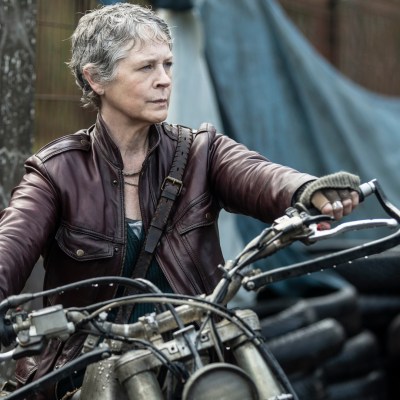The Walking Dead franchise keeps hobbling on like the trailing walker in a massive herd. With a litany of sequels and spinoffs that hone in on favorite characters and add new context to past storylines, the material has expanded far past comic book creator Robert Kirkman’s original scope for the universe. Diluting a series with too much of an extended world certainly isn’t unique to The Walking Dead, but it unfortunately makes people forget just how monumental the post-apocalyptic tale was during its heyday.
Everybody except the most diehard superfans have long laid The Walking Dead and its peripheral series to rest. Daryl Dixon: The Book of Carol premiered on AMC to only 0.576 million live viewers on September 29. To give the show the benefit of the doubt, streaming and DVR recording are the preferred methods of watching TV in 2024. At the same time, this excuse doesn’t quite let the sinking ship off the hook.
On October 12, 2014, The Walking Dead’s fifth season premiere “No Sanctuary” ate up an ungodly 17.29 million viewers. For those who aren’t good with numbers, that’s 30 times more people! For a show about the dead, no TV vehicle has ever been more alive than this series in the early-to-mid 2010s. This type of popularity is what made AMC think that fans would never get tired of it. In the process, it soiled the reputation of a genuine phenomenon.
The Walking Dead combined old-school, word-of-mouth watercooler discourse with newer-age social media hype to reach an unprecedented audience that has never been seen before or since on basic cable TV. The quality of the production, which included underrated, award-worthy acting, frightening special effects, and a haunting score by Bear McCreary cemented the comic book adaptation into the pop culture zeitgeist in all the right ways. People who never would touch a piece of zombie material in the past (*cough* me *cough*) wanted to know what all the clamoring was about.
That hungry audience was rewarded with one of the series’ truest gems. “No Sanctuary” exemplified the substance behind the stylistic chatter. Rick Grimes (Andrew Lincoln) and his group of survivors think they have discovered a haven at the end of the fourth season in Terminus. This train station will supposedly possess a reprieve for the downtrodden group that has just spent the better portion of two seasons fighting against the show’s best villain, The Governor (David Morrissey). Instead, Rick’s unit is deceived by the leaders of Terminus and is at the mercy of the cannibalistic residents who have hunkered down there.
Like the best Walking Dead episodes, “No Sanctuary” sets up our heroes for heartbreaking devastation. Gareth (Andrew J. West) and his family run a traumatizing operation that smoothly tricks new inhabitants into their grasp before killing and eating them. The whole thing happens so quickly that most of their victims are helpless to the proceedings. Not all survivor groups have Carol (Melissa McBride) though. This episode is an initial part of Carol’s legacy and why shows like Daryl Dixon: The Book of Carol are still trying to milk every last part of her character arc.
Carol’s attack on Terminus that saves Rick and the others not only strengthens the relationship between the two characters, but it sets them up as irreplaceable parts of the show’s story for years. With the aforementioned historic audience in tow, folks who were unfamiliar with The Walking Dead got bit in the face by a zombie potpourri of the series’ best elements. Carol’s character development from an abused wife and mother to a ruthless, sometimes cold, gladiator of the apocalypse symbolized the show’s fearlessness and revolutionary nature.
In the world of The Walking Dead, it is the people who matter the most, not the walkers. Anybody can save the world when there are no rules. The series broke traditional tropes and boundaries by catapulting untraditional protagonists to the top of the food chain. It made many people at home feel seen and heard. The Walking Dead allowed a niche genre to morph into a relatable parable of liberating humanity and discovering themselves.
“No Sanctuary” represents The Walking Dead’s blessing and curse. The show was such a rarity that any smart business executive running a TV network would find ways to exact every bit of substance from it, even when there’s nothing left. Those 17 million fans were supposed to be a sign that there was an unprecedented audience for zombie fiction, but a lot of The Walking Dead’s best years had already gone in the rearview mirror. Retread storylines and a lack of creativity forced the show to decay only a couple of years after its peak. Once people were in the series’ orbit, they wanted more of the hype they were promised, but it was never delivered.
The Walking Dead lives today more through other apocalyptic series than its own spinoffs. The Last of Us may be HBO’s grandest series running right now. The slow-burn stories and spectacular acting resemble The Walking Dead during its prime. All of Us Are Dead took over the Netflix top 10 when it premiered in 2022. People are still searching for that adrenaline boost provided by TWD circa “No Sanctuary”, but it’s unlikely it will ever be found. Rick, Carol, Daryl (Norman Reedus), and the rest of the gang roamed onto the scene at the exact right moment. They ate everything up and left no crumbs.
The post No Sanctuary: The Night The Walking Dead Became a Phenomenon appeared first on Den of Geek.




0 Commentaires